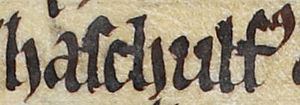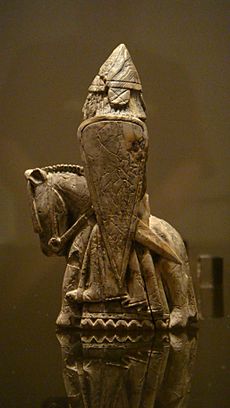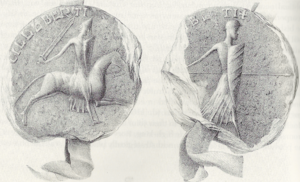Ascall mac Ragnaill facts for kids
Quick facts for kids Ascall mac Ragnaill |
|
|---|---|
| King of Dublin | |

Ascall's name as it appears on folio 46v of British Library Royal 13 B VIII (Expugnatio Hibernica): "Hasculphus".
|
|
| Reign | 1160 - 1170 |
| Predecessor | Brodar mac Torcaill |
| Born | 1124 |
| Died | 16 May 1171 Dublin |
| House | Meic Torcaill |
| Father | Ragnall mac Torcaill |
Ascall mac Ragnaill (died 16 May 1171) was the very last Norse-Gaelic king of Dublin. He was part of the Meic Torcaill family, which was very important in Dublin since the early 1100s.
During Ascall's time, many groups fought for control of the rich coastal kingdom of Dublin. Members of his own family, people from the Isles, and Irish leaders all held power for short periods. For much of this time, however, Diarmait Mac Murchada, King of Leinster, was the main ruler over Dublin.
In 1166, after his friend Muirchertach Mac Lochlainn, High King of Ireland died, Mac Murchada faced many enemies. At this difficult moment, the people of Dublin stopped supporting him. This led to him being forced out of Ireland that same year. But soon after, he returned with a lot of help from English soldiers. In late 1170, Dublin itself was captured by the combined forces of Mac Murchada and a powerful English lord, Richard de Clare, Earl of Pembroke.
After the Norse-Gaelic kingdom fell, Ascall and other Dublin leaders had to escape. They fled to what some old writings call the "northern islands." This probably meant the Kingdom of the Isles or the Earldom of Orkney. About a year later, after Mac Murchada died, Ascall tried to take back his kingdom from the English. Sadly for him, his attempt to invade Dublin failed completely. He was captured and executed by the English governor of the town. Right after Ascall's defeat, Dublin was surrounded by Irish and Islesmen forces. But the town stayed firmly under English control. Before the end of that year, Dublin became a direct possession of Henry II, King of England. He made it an English royal town.
Contents
Ascall and His Family
Ascall's father was Ragnall mac Torcaill. Ragnall might have also been a King of Dublin. Both men were part of the Meic Torcaill family. This family owned a lot of land in the kingdom. Several members of this Norse-Gaelic family were kings in the 1100s. One of them was Ascall's uncle, Brodar mac Torcaill, King of Dublin, who died in 1160.
Around the middle of the 1100s, the kingdom of Dublin was under the rule of Diarmait Mac Murchada, King of Leinster. Mac Murchada's own main ruler was Muirchertach Mac Lochlainn, King of Cenél nEógain. The year after Brodar's death, many old records say that Mac Murchada, with Dublin soldiers, officially accepted Mac Lochlainn as his ruler.
In 1162, the Annals of Ulster (an old Irish history book) shows that Mac Murchada gained great power over Dublin. His success might have come from help he got from Mac Lochlainn. For example, the same book says Mac Lochlainn attacked Dublin that year. This attack might have been to stop the Dubliners from trying to make Gofraid mac Amlaíb, King of the Isles their king, as told in the Chronicle of Mann.
Records from the mid-1100s suggest that the Leinster rulers of Dublin worked well with Dublin's local leaders. The rise of the Meic Torcaill family during this time fits this idea. However, if there wasn't a local ruler, the Dubliners seemed to look for leaders from the Isles. They preferred this over having a ruler who wasn't from Leinster, as shown by their attempt to make Gofraid king.
Mac Murchada's strong power in Dublin is shown by several church gifts and appointments. Also, Dublin's forces took part in two big military actions in 1164 and 1165. These might have been under Mac Murchada's command. The 1165 campaign, recorded in the Annals of Ulster and other texts, involved ships off Wales. They were helping Henry II, King of England. The 1164 campaign, also in the Annals of Ulster, was part of a failed invasion of Scotland. This was led by Somairle mac Gilla Brigte, King of the Isles.
Mac Murchada's Fall and New Rulers

In 1166, Mac Lochlainn was killed. This left Mac Murchada to face his enemies alone. Another person trying to become High King of Ireland was Ruaidrí Ua Conchobair, King of Connacht. In the same year Mac Lochlainn died, Ua Conchobair and his allies forced Mac Murchada out of Dublin and out of Ireland completely. Because of this, Ua Conchobair was recognized as the High King of Ireland.
According to the Annals of the Four Masters, Ua Conchobair gained Dublin's support by giving them 4,000 cows. As a result, Dubliners were part of Ua Conchobair's army when he marched to Drogheda and Leinster. There, he forced the kings of Airgialla and Leinster to accept his rule. Dublin seemed to be a key part of Ua Conchobair's power. It was clear that Mac Murchada was in trouble without Dublin's support.
An old text, La Geste des Engleis en Yrlande, says that Ascall ("MacTurkyl of Dublin") had left his former ruler. The Annals of Inisfallen specifically state that Mac Murchada was only forced out of Ireland after the people of Leinster and Dublin turned against him. Although Ua Conchobair seemed to let Mac Murchada keep some of his family lands, the Annals of the Four Masters shows that the Leinstermen and Dubliners helped Tigernán Ua Ruairc, King of Bréifne force Mac Murchada from his last bit of power and into exile.
The next year, Ua Conchobair held a large meeting at Athboy. The Annals of the Four Masters says that 13,000 horsemen attended. 1,000 of these came from Dublin. One of the many rulers at this meeting was a man named Ragnall mac Ragnaill, called "lord of the foreigners." His name suggests he was either Ascall's brother (who isn't mentioned elsewhere) or a mistake by the person writing the history, meaning Ascall himself.
Meanwhile, after being forced out of Ireland, Mac Murchada went to Europe to find Henry II. He got permission to hire soldiers from Henry's lands. In the autumn of 1167, Mac Murchada and his English allies arrived in Ireland. They settled at Ferns. Ua Conchobair responded by attacking Mac Murchada's lands. This campaign, told in the Annals of Tigernach, included military help from Dublin. With Mac Murchada temporarily under control, Ua Conchobair allowed him to keep at least some of his family lands.
English Arrive and Dublin Falls
The situation in Ireland stayed mostly the same until many English soldiers arrived in the summer of 1169. After this, some of Mac Murchada's former followers started to join him again. However, according to La Geste des Engleis en Yrlande, the kings of Uí Fáeláin and Osraige, and Ascall (described as the "lord" of Dublin by this source), stubbornly refused to support Mac Murchada.
To show his strength and perhaps keep the Dubliners on his side, the Annals of the Four Masters says that Ua Conchobair led an army to Tara. There, he was joined by the forces of the kings of Ulaid and Airgialla. Then, the combined army marched on Dublin. However, the next year, even more English support arrived for Mac Murchada. In August 1170, Richard de Clare, Earl of Pembroke landed in Ireland and quickly captured Waterford.
Soon after, Clare married Mac Murchada's daughter, Aoife. This made him the likely heir to the kingship of Leinster and the rule over Dublin. Not surprisingly, later in September, the combined forces of Mac Murchada and Clare marched on Dublin. They faced Ua Conchobair and his army there.
If the Annals of the Four Masters is correct, the Dubliners switched sides at this point. They left Ua Conchobair and their town was burned down. On the other hand, the Expugnatio Hibernica (an old book from the 1100s) says that while Ua Conchobair and Mac Murchada's forces were talking, an English army led by Miles de Cogan and Raymond le Gros successfully attacked the town. They caused a lot of damage and killed many people.
While the Annals of the Four Masters says the Dubliners were killed in their fort, Expugnatio Hibernica says most of them escaped and kept most of their belongings. The same source says that Ascall and the Dubliners managed to escape to the "northern islands." This term could mean Orkney. It might also refer to the Hebrides or the Isle of Man. If so, it suggests that the Dubliners still had strong connections with the Isles. According to La Geste des Engleis en Yrlande, Dublin was captured on September 21.
Final Defeat and Death
Within weeks of Mac Murchada's death in early May, Expugnatio Hibernica tells us that Ascall returned to Dublin. Both Expugnatio Hibernica and La Geste des Engleis en Yrlande say that Ascall's forces were made up of heavily armored Islesmen and Norwegians. The first book says Ascall had sixty ships, while the second says one hundred. Both sources mention that Ascall's followers included a famous warrior named "John the Mad." This person might be the same as Sveinn Ásleifarson, a character from old Norse stories.
According to La Geste des Engleis en Yrlande, the invaders landed at the "Steine," on the south side of the River Liffey. They then set up camp outside the town walls. Expugnatio Hibernica says they attacked the eastern gate, which matches St Mary's Gate, the target mentioned in La Geste des Engleis en Yrlande. Unfortunately for Ascall, the attack failed completely. He was captured and died. Both books say that the town's defenders, led by Cogan and his brother Richard, successfully fought off the invaders. They killed John and captured Ascall as he tried to escape to his ships.

Expugnatio Hibernica reveals that Ascall's life was first saved so he could be ransomed (traded for money). However, both this book and La Geste des Engleis en Yrlande report that he was soon beheaded because he refused to cooperate.
The deaths of Mac Murchada and Ascall created a power gap in Dublin that others tried to fill. Right after Ascall's defeat, Ua Conchobair surrounded the English-controlled town. Expugnatio Hibernica records that he and Lorcán Ua Tuathail, Archbishop of Dublin sent for Gofraid and others in the Isles. They asked them to block Dublin by sea. According to the book, "the threat of English control, inspired by the English successes, made the men of the Isles act even faster. With the wind from the north-west, they immediately sailed about thirty ships full of warriors into the harbor of the Liffey."
Sadly for the Irish, Islesmen, and Dubliners, the blockade failed. Dublin stayed firmly in English hands. Ascall was the last Norse-Gaelic King of Dublin. Before the end of the year, Clare gave Dublin to his own lord, Henry II. Henry then made it an English royal town.
There is evidence from after Ascall's death that he had given the church of St Brigid and its lands to the Holy Trinity priory (Christ Church Cathedral). An old record also mentions a "gardha" or "garð" (Gaelic and Old Norse words for a small settlement) that belonged to Ascall near Dublin's western gate. Around 1190, the city gate at Nicholas Street was known as "porte Hasculf," which means "Ascall's Gate."




